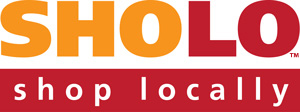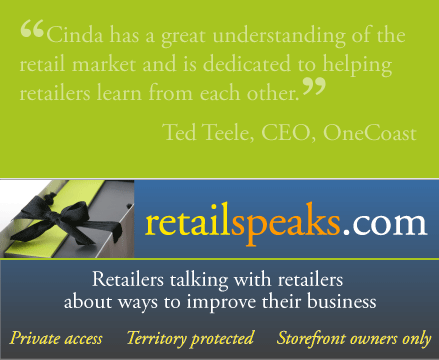 As you know from last week’s post, I am bursting-at-the-seams-proud of an Indiana “shop local” project appropriately named ShoLo. They stand as a shining example of just what can be done when community business owners pull together.
As you know from last week’s post, I am bursting-at-the-seams-proud of an Indiana “shop local” project appropriately named ShoLo. They stand as a shining example of just what can be done when community business owners pull together.
According to Joya Helmuth, owner of Spark Fine Stationery, the seeds were sewn during a regular meeting of the Women in Retail Group (facilitated by the Small Business Development Center). She shared customers’ comments about their preference for locally owned businesses, then suggested members of the group “capitalize on it as a way to differentiate ourselves from national/chain stores. If it’s important to our customers, we should shout it from the rooftops!”
By the time the meeting ended, Joya had a partner in crime—Rebecca Maalouf, owner of Camelia, The Makeup Store. Within three months of launching, ShoLo had swollen to fifty members.
Recently, I asked Joya and Rebecca about their experience setting up ShoLo, and what advice they had for other retailers hoping to do the same.
I hear ShoLo’s launch was particularly timely for you, Rebecca, given the appearance of national chains nearby.
Rebecca: Three years after I opened my cosmetic specialty business, and on the same day I revealed my decision to move to a much more visible location, the competition moved in. Sephora came first, then Ulta. One year later, with these cosmetic giants less than a mile away from my own creation, ShoLo was created.
What kind of start up costs were involved in launching ShoLo, and who paid for them?
Joya: Rebecca and I each put in about $175, and paid ourselves back 2 months later. Mainly it covered the cost of the domain name and web hosting for a year, filing fees for establishing the business, and part of the first printing of our bag inserts. By the time we got that far, we had over 20 members and could stay afloat.
How many businesses were on board when ShoLo first launched?
Joya: Ours—two. But we had instant buy-in from everyone we talked to, and with our low joining fee ($20) it was a no-brainer for most everyone. Within three months we had about 50 members.
What was the biggest challenge ShoLo faced?
Joya: Getting the word out. With no real budget for media, and the holidays coming, it was imperative for us to get exposure, and fast.
How did you overcome it?
Joya: We were invited by one of our first members to a meeting of retailers and media – about 12 people – to discuss how to get some positive news out there. All we read about in our local paper were store closings. The retailers that invited us were already working to spin it around – closed businesses are of no use to readers/shoppers – how about telling people about the shops that are open and needing their business?
How did you get so much local media behind the campaign?
Joya: Media jumped on it. We were aided a great deal by the election just ending, holidays coming, and the dearth of positive news to report. One of our larger radio groups wrote a fabulous ad before even talking with us. Once we approved it, it was on the air the next week. They shared it with the other radio groups and it made a huge impact, as that encompassed about 10 of our local stations.
We also took advantage of our local tv station’s free ‘Business Break’; a 2-minute promo for any business. Rebecca filmed it and they reran it several times in November and December.
Other local magazines and outlets were more than happy to promote it, since they are community publications and want to promote anything and everything local. I designed ads that they could use as fillers whenever they needed it, and when asked, wrote feature articles for them to include.
What did you ask local media to do in exchange for their logos being included on the ShoLo site?
Joya: Promote us in any way they could. One of the things we learned right away is that we couldn’t pay for media – not because we didn’t have the money, but because if we paid for one, the others would want to be paid too (and rightly so).
We are very grateful for all the different outlets that have seen the value in ShoLo. If you look on the ‘media sponsors’ page of the site, there’s a ton. We decided to make a media sponsor page after these organizations wanted to support and join ShoLo, but a regular membership didn’t exactly make sense.
How do ShoLo members get consumers behind the campaign?
Joya: We offer bag inserts to our members at cost. We ask members to promote ShoLo on their own through marketing efforts, their websites, etc. At Spark, when someone makes a purchase, we thank them for shopping at a local business and give them the insert so they’re aware of it on a one-on-one interaction (as opposed to throwing it in the bag).
Rebecca: The ShoLo movement captured the sentiment [that the big box experience didn’t compare] and the realization that by shopping locally, more dollars were invested into their own community…. I do not scold them when they tell me they have been elsewhere, but I do thank them when they say that part of their decision to shop with our locally owned store was made to support locally owned businesses, and that they want to show their appreciation for what we do have to offer.
How has participation in ShoLo improved business for participants?
Rebecca: “I try to shop locally as often as possible.” I hear this cheery refrain repeated on a regular basis these days. Funny thing, I’ve been in business for five years, but not many customers have made this statement until recently I can only assume that these heartfelt declarations are the result of our shop local campaign, Sholo. I consider this the successful culmination of consumers responding to the shop local message, the nudge that they needed to help them make one of their many spending decisions.
Placing the ShoLo flyers in every bag ensures that the consumers who are not aware of the economic effects of shopping locally are positively re-enforced after the sale, encouraging them to repeat the process and shop locally again. The full circle effect of the campaign is one more tool I can use to differentiate my business and reward my customers for shopping in my store.
What’s your best advice for retailers interested in creating similar programs in their own communities?
Joya: Don’t go it alone. It’s a lot of work, and dealing with other business owners (who usually are Type A personalities!) can be a challenge. Get a group together that can commit to sharing the workload – this will naturally help in using everyone’s contact lists to recruit members.
One of the things we are currently considering…is becoming a chapter of the American Independent Business Alliance (AMIBA). We didn’t really look into this organization before we jumped in, and it would have helped us prepare, since they could ask us the right questions ahead of time.
Rebecca: The ShoLo movement will soon be a community wide movement, resulting in a proud group of strong, independently owned businesses that the community supports and protects as their own.
- – - – -
Doesn’t get much better than that. Thanks, Joya and Rebecca, for sharing your wisdom and enthusiasm!


Click here to tell me what you think....
Great story Joya and Rebbecca–what an inspiration to hear two retailers taking things in their own hands! I know how busy you guys are so can really appreciate the dedication it took to create ShoLo (cute name btw!).
As always, I’m totally impressed with your efforts – and outstanding results!
Joya-
I’d heard a bit about this and had started seeing great little vinyl signs on storefronts — brilliant marketing! Is there a list of local vendors who are part of the ShoLo group? What can I do to get Cassady on-board?
-jo